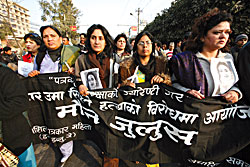 KIRAN PANDAY |
In between 30 years of royal authoritarianism and 15 years of Maoist insurgency and counter-insurgency, the Nepali media exercised unfettered freedom for hardly five years in the early 1990s. Journalism has always been a dangerous field, attracting only the committed, obsessed and the occasional desperado.
A career in the Nepali media usually implies a lifetime of hardships. Journalists are accustomed to threats and physical assaults especially if they are rural reporters or editors. But the gruesome murder of Uma Singh in Janakpur this week was shocking by all standards.
By all accounts, Uma was an exceptional person. She stuck to the calling despite repeated threats to her life and ultimately perished pursuing some of the highest goals of the mission journalism: activism, belief, courage, doggedness, energy and faith.
She was not someone who had the ears of powerful and could call up the high and mighty during difficult times. Living and working in a small town, she lacked access to sympathetic aidocrats, the international press or diplomatic missions. She was a reporter, commentator, editor and news reader all rolled into one, grinding the wheels of a local FM radio station in a town where moneybags and musclemen are inextricably intertwined.
Terrorists normally don't mess with females for the fear of losing their 'saviour' image. Even criminals who have little hesitation in abducting children for ransom mostly stay clear of women. When Maoists abducted Uma's father, mother and brother from Siraha three years ago, they released her mother. Women are considered too weak to be worth killing.
It is inconceivable that either Maoists, or any of their offshoots masquerading as messiahs of Madhesi freedom, considered a radio journalist a threat worthy of physical elimination. The lack of apparent motive and the brutality of her murder has shaken every mediaperson in the mofussil. It is possible that the message was in the method. Apparently there is an armed group in the Tarai, which believes that a revolution is not a tea party.
The second message of Uma's murder was truly terrifying. The attackers seemed to be telling the residents of her Rajaul neighborhood in Janakpur, "Look, we can come for your sister or daughter and no one can protect you, not even the government you have elected."
Maoist minister for Pashupati affairs, Gopal Kirati, is perhaps correct in arguing that thegovernment should provide every citizen with a gun rather than pretending to offer them security. But how about children? Should we arm them too?
Then there is the complete breakdown of social cohesion in the Tarai. The 'us' is the family and everybody else is 'them'. There are Pahadis, Madhesis, Janjatis, Dalits, upper castes, lower castes, forward castes, middle castes, the casteless Jogis and Sanyasis, Muslims, Christians. But no Maithils, Bhojpuriyas, Awadhiyas or Tharus, let alone Nepalis, in the politically charged plains of Tarai-Madhes. If attempts of political agglomeration are not made with some urgency, society risks descending into the Hobbesian world of perpetual war.
Fortunately, the search for a political solution seems to have begun with the formation of a unified political front of Jaikrishna Goit and Jwala Singh who have come together again to form the Tarai Jantantrik Party. They could establish their credentials by first helping to track down Uma's killers.
Nothing debases a movement like the blood of the defenseless and nothing degrades politics like needless violence. Jaikrishna and Jwala need to junk Mao and go back to Marx to save Mithila, Uma's homeland as much as theirs.



